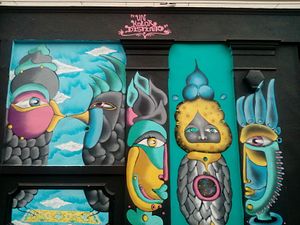A small group of foreign tourists are standing in a street corner at London, carefully listening as their guide describes the area. One of the tourists stops the guide and asks, “Why are Bengalis not widely visible here, though you’re saying it’s Banglatown?” Unfortunately the tour guide didn’t have satisfactory answers.
Brick Lane is a street in east London, England. The area is widely known for two things: graffiti and Indian curry restaurants. The graffiti arts were not developed by Bengalis, but almost every one of the curry restaurants were owned and operated by them. The entire area came to be called Banglatown or the Curry Capital.
Jewish immigration to the area dominated through the 19th and early 20th centuries, but in the later part of the 20th century, Bangladeshis become the major immigrant group. As a symbol of the changing demographics, a former chapel-turned-synagogue was repurposed as the London Jamme Masjid (Great London Mosque). The famous curry restaurants also opened to serve the growing Bengali community.
But this history is already fading into the past. The graffiti still exists but curry restaurants have declined in numbers, as has the Bengali population. Bengalis are shifting out to other parts of eastern London like East Ham, Ilford, or Barking. Activities and cultural flows are now rarely visible in this area; many Bengali residences have been sifted over to other communities, and shops changing hands as well. For example a renowned Bengali restaurant, Clifton’s, was replaced by a Turkish chain, Efes.
How do Bengalis explain this mini-diaspora?
“It’s our culture to take care of elderly family members; so whenever our new generation tried to move on in other areas, to change and find new prospects, they took each and every family member as well,” says Osman Gani, a senior community leader in Brick Lane who arrived in 1976.
“We can’t blame to our next generation as they didn’t directly came from Bangladesh; rather they were born and brought up here as British citizens. So they might have different views than us about taking care of Brick Lane’s Bengali character. Maybe they don’t want to it see it destroyed but neither do they want to invest valuable time and energy here,” he added.
Gani recalls earlier days, when he estimates up to 50,000 Bangladeshis were living in the Spitalfields and Banglatown ward at the community’s peak. Most arrived in London between 1976 and 1990. The area became known as Banglatown thanks to a combination of government cooperation and extreme efforts by British Bengalis.
“Some people want to compare our popularity with the brand value of Chinatown,” said Gani. “But Chinatown is … a commercial and entertainment zone whereas Banglatown is [the result of] a long cultural diaspora…. Banglatown is really a township, not simply a street market.”
Shah Munim is a leading businessman and community leader who came here in the late ‘90s and now operates several businesses, including the famous curry house Shaad Grill. He sees a simple explanation for the gradual decline of the Bengali population: “Money matters. People started selling their houses [as prices ballooned]… And when you sell your home, other communities will come and grow naturally.”
Munim added, “It’s also true that we Bengalis are not much united to keep and uphold our heritage and nurse it. We didn’t even think about to setting up a good souvenir shop or doing research on how curry industries can sustain here…. Still we have prospects if community members agreed to stand up together.”
According to Munim, “Banglatown will disappear if we don’t take immediate initiatives.”
Gani, however, believes that “Bengalis will be in here in the future but in a different form,” with less of a concentrated population.
Shakil Bin Mushtaq is a Bangladeshi-born freelance journalist and author.










































